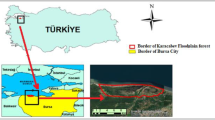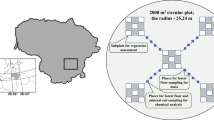Abstract
This study aimed to improve knowledge about the nutritional status, site requirements and site classification for European ash (Fraxinus excelsior L.) and sycamore maple (Acer pseudoplatanus L.) by reinvestigating young plantations from 1991/1992 on windfall-affected areas in Bavaria/Germany after another decade. Compared to the first survey in 1995, most stands improved their nutritional status until 2006. With the data set of element concentrations in leaves of ash and sycamore available, the range of adequate nutrition could be determined for these species in the pole stage phase. Both species show considerable height growth on a wide range of sites. Mean annual height growth of dominant sycamore trees increased with rising foliar N or P concentrations but not for Ca, Mg, K, Mn, Fe and Al. For ash, there was no relationship between the foliar nutrient level of any element and mean annual height growth. However, total height around age 20 was favourably influenced by high base saturation and a good water supply at well-drained sites. On acid soils, where nutrients are delivered by subsurface water flow, well-growing stands are found as well. Soil water status according to the state forest soil classification had no significant impact on mean annual height growth. Ash and sycamore show reduced productivity on some (moderately) dry soils and fail on poorly drained moist sites. Based on these results, the classification of forest sites suitable for ash and sycamore within the Bavarian study sites was revised.










Similar content being viewed by others
References
Arbeitskreis Standortskartierung (ed) (1996) In der Arbeitsgemeinschaft Forsteinrichtung. Forstliche Standortsaufnahme. Landwirtschaftsverlag Münster-Hiltrup
Besnard G, Carlier G (1990) Potentiel hydrique et conductance stomatique des feuillus de frêne (Fraxinus excelsior L.) dans une fôret alluviale du Haute-Rhône francaise. Ann Sc Forest 47:353–365
Binner V, Bosch T, Elling W, Gulder HJ, Kölling C (2000) Gibt es eine Nährstoff-Mangelgrenze der Esche? AFZ/Der Wald, Heft 5:220–222
Braun HJ (1977) Zum Wachstum und zur Produktivität des Wasserverbrauchs der Baumarten Acer pseudoplatanus L., Acer platanoides L. und Fraxinus excelsior L. Z. f. Pflanzenphysiologie 84:459–462
Carlier G, Peltier JP, Gielly L (1992) Comportement hydrique du frêne (Fraxinus excelsior L.) dans une formation montagnarde mesoxerophile. Ann Sci Forest 49:207–223
Dahmer J (1997) Wurzelentwicklung von Laubholzpflanzen auf Sturmkahlflächen. In: Bayerische Landesanstalt für Wald und Forstwirtschaft (ed) Pflanzverfahren und Wurzelentwicklung. LWF-Bericht No. 15, Freising
Daniel TW, Helms JA, Baker FS (1979) Principles of silviculture. McGraw-Hill, New York
Devauchelle R, Levy G (1977) Propriétés stationelles et croissance du Frêne dans l′ Est de la France. Etude de certaines caractéristiques de cette essence. Ann Sci Forest 34(3):231–244
Fiedler HJ, Nebe W, Hoffmann FM (1973) Forstliche Pflanzenernährung und Düngung. G. Fischer Verlag, Stuttgart
Gulder HJ, Kölbel M (1993) Waldbodeninventur in Bayern. Forstliche Forschungsberichte München, No. 132
Hagen-Thorn A, Callesen I, Armolaitis K, Nihlgard B (2004) The impact of six European tree species on the chemistry of mineral topsoil in forest plantations on former agricultural land. For Ecol Manage 195:373–384
Hagen-Thorn A, Stjernquist I (2005) Micronutrient levels in some temperate European tree species: a comparative field study. Trees 19(5):572–579
Hein S (2004) Zur Steuerung von Astreinigung und Dickenwachstum bei Esche (Fraxinus excelsior L.) und Ahorn (Acer pseudoplatanus L.). Albert-Ludwigs-Universität und Forstliche Versuchs- und Forschungsanstalt Baden-Württemberg, Schriftenreihe Freiburger Forstliche Forschung, Band 25, Freiburg (Breisgau)
Heitz R (1998) Umbau von Fichtenreinbeständen in naturnahe Mischwälder – Auswirkungen auf bodenchemischen Zustand und Bioelementhaushalt. Dissertation LMU München
Herault B, Thoen D, Honnay O (2004) Assessing the potential of natural woody species regeneration for the conversion of Norway spruce plantations on alluvial soils. Ann For Sci 61:711–719
Hölscher D, Schmitt S, Kupfer K (2002) Growth and leaf traits of four broad-leaved tree species along a hillside gradient. Forstw Cbl 121:229–239
Holdenrieder O, Kowalski T (2008) Eine neue Pilzkrankheit an Esche in Europa. A new fungal disease of ash in Europe. Schweizerische Zeitschrift Forstwesen 159:45–50
Kerr G, Cahalan C (2004) A review of site factors affecting the early growth of ash (Fraxinus excelsior L.). For Ecol Manage 188:225–234
Khalil AAM, Grace J (1992) Acclination to drought in Acer pseudoplatanus L. (Sycamore) seedlings. J Exp Bot 43(257):1591–1602
Knorr A (1987) Ernährungszustand, Standortsansprüche und Wuchsleistung der Esche (Fraxinus excelsior L.) in Bayern. Forstliche Forschungsberichte München, No. 82
Kowalski T (2006) Chalara fraxinea sp. nov. associated with dieback of ash (Fraxinus excelsior) in Poland. Forest Pathol 36:264–270
Kraft G (1884) Beiträge zur Lehre von den Durchforstungen, Schlagstellungen und Lichtungshieben. Hannover
Le Goff N, Levy G (1984) Productivité du frêne (Fraxinus excelsior L.) en région Nord-Picardie. B. Etude des relations entre la productivité et les conditions de milieu. Ann Sci Forest 41(2):135–170
Levy G, Le Goff N, Léfèvre Y, Garros L (1992) Les exigences stationelles du frêne dans le nord et le nord-est de la France. Rev For Fr Special 44:20–26
Löf M, Karlsson M, Sonesson K, Welander TN, Collet C (2007) Growth and mortality in underplanted tree seedlings in response to variations in canopy closure of Norway spruce stands. Forestry 80:371–383
Marigo G, Peltier JP (1996) Analysis of the diurnal change in osmotic potential in leaves of Fraxinus excelsior L. J Exp Bot 47(299):763–769
Marigo G, Peltier JP, Pautou JGG (2000) Success in the demographic expansion of Fraxinus excelsior L. Trees 15(1):1–13
Maurer E (1963) Waldbauliche und holzkundliche Untersuchungen an Eschen aus dem Allgäu. Forstw. Cbl. 82(5–6):162–188
Mussong M (1989) Multiple Regressionsmodelle maximaler Treffsicherheit für die Anwendung in SAS-Systemen. Forstarchiv 60:236–238
Nüßlein S (1999) Zielorientierte Pflege der Edellaubbäume. AFZ/Der Wald, Heft 12:617–619
Nüßlein S (2000) Ein Kraftakt für den Mischwald. In: LWF (ed) Forstwirtschaft in stürmischen Zeiten. LWF-Aktuell No. 26, Freising
Oliver CD, Larsen BC (1996) Forest stands dynamics. Wiley., New York
Pinto PE, Gégout JC (2005) Assessing the nutritional and climatic response of temperate tree species in the Vosges Mountains. Ann For Sci 62:761–770
Quinn GP, Keough MJ (2002) Experimental design and data analysis for biologists. Cambridge University Press, Cambridge
Schneidewind A (2005) Untersuchungen zur Standorteignung von Acer pseudoplatanus L. als Straßenbaum in Mitteldeutschland unter besonderer Berücksichtigung abiotischer und biotischer Stressfaktoren. Tenea Verlag Ltd, Clifton
Thoroe C, Ollmann H (2001) Die zukünftige Entwicklung des Holzmarktes in Deutschland, Europa und weltweit–Chancen für schnell wachsende Baumarten? Forst Holz 56:75–80
Van den Burg J (1985) Folia analysis for determination of tree nutrient status—a compilation of literature data (1. up to 1984). Rapport No. 414, Rijksinstituut voor onderzoek in de bos- en landschapbouw (Institut for Forestry and Urban Ecology) “De Dorschkamp”. Wageningen, The Netherlands
Van den Burg J (1990) Folia analysis for determination of tree nutrient status—a compilation of literature data (2. 1985–1990). Rapport No. 591, Rijksinstituut voor onderzoek in de bos- en landschapbouw (Institut for Forestry and Urban Ecology) “De Dorschkamp”. Wageningen, The Netherlands
Wagner S (1999) Ökologische Untersuchungen zur Initialphase der Naturverjüngung in Eschen-Buchen-Mischbeständen. Schriftenreihe der Forstlichen Fakultät der Uni Göttingen und der Niedersächsischen Forstlichen Versuchsanstalt Göttingen 129, Sauerländer’s Verlag
Wardle P (1961) Biological flora of the British Isles—Fraxinus excelsior L. J Ecol 49:739–751
Weber G (1998) Wachstum und Ernährungszustand junger Eschen (Fraxinus excelsior L.) und Bergahorne (Acer pseudoplatanus L.) in Abhängigkeit von der Basen- und Aluminiumsättigung und vom Wasserhaushalt natürlicher Böden – Topfversuche und Freilandinventur. Hieronymus, München
Weber G, Bahr B (2000a) Wachstum und Ernährungszustand junger Eschen (Fraxinus excelsior L.) und Bergahorne (Acer pseudoplatanus L.) auf Sturmwurfflächen in Bayern in Abhängigkeit vom Standort. Forstw Cbl 119:177–192
Weber G, Bahr B (2000b) Eignung bayerischer Standorte für den Anbau von Esche (Fraxinus excelsior L.) und Bergahorn (Acer pseudoplatanus L.). Forstw Cbl 119:263–275
Weber G, Claus M (2000) The influence of chemical soil factors on the development of VA mycorrhizas of ash (Fraxinus excelsior L.) and sycamore (Acer pseudoplatanus L.) in pot experiments. J Plant Nutr Soil Sci 163:609–616
Weber G, Rehfuess KE, Kreutzer K (1993) Über den Einfluß naturnaher Waldwirtschaft auf den chemischen Bodenzustand. AFZ Heft 2:68–71
Weber-Blaschke G, Claus M, Rehfuess KE (2002) Growth and nutrition of ash (Fraxinus excelsior L.) and sycamore (Acer pseudoplatanus L.) on soils of different base saturation in pot experiments. For Ecol Manage 167:43–56
Weber-Blaschke G, Rehfuess KE (2002) Correction of Al toxicity with European ash (Fraxinus excelsior L.) growing on acid soils by fertilization with Ca and Mg carbonate and sulfate in pot experiments. For Ecol Manage 167:173–183
Weiser F (1995) Beitrag zur Existenz von Ökotypen bei gemeiner Esche. Forstarchiv 66:251–257
Wittich W (1961) Der Einfluß der Baumart auf den Bodenzustand. AFZ Heft 2:41–45
Zollner A, Kölling C (1994) Eschenkulturen auf ungeeignetem Standort. AFZ Heft 2:61–64
Acknowledgments
The authors thank the Bavarian State Ministry of Agriculture and Forestry for financial support of the project (grant number ST180) and the Department of Forest Nutrition and Water Resources, Technische Universität München, for performing the foliar analyses. The authors and former students of Professor Dr. Karl-Eugen Rehfuess are deeply grateful for his useful recommendations on the draft paper and cordially compliment him on his 75th birthday in 2008.
Author information
Authors and Affiliations
Corresponding author
Additional information
Communicated by A. Merino.
Dedicated to Professor Dr. Karl-Eugen Rehfuess on his 75th birthday.
Rights and permissions
About this article
Cite this article
Weber-Blaschke, G., Heitz, R., Blaschke, M. et al. Growth and nutrition of young European ash (Fraxinus excelsior L.) and sycamore maple (Acer pseudoplatanus L.) on sites with different nutrient and water statuses. Eur J Forest Res 127, 465–479 (2008). https://doi.org/10.1007/s10342-008-0230-x
Received:
Revised:
Accepted:
Published:
Issue Date:
DOI: https://doi.org/10.1007/s10342-008-0230-x




